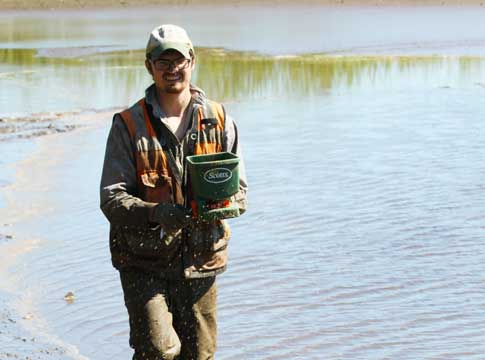Related News
Related News
-
Sustainability Snapshot - Celebrating Energy Efficiency Projects in the Community
Sustainability Snapshops highlight impactful projects completed by EWEB's Customer Solutions department, as a way to celebrate the meaningful work happening behind the scenes.
Find Out More -
McKenzie Valley electric service territory realignment study reaches key milestone
EWEB Commissioners approved a resolution authorizing the General Manager to negotiate and execute agreements with Lane Electric Cooperative regarding a potential realignment of electric service territory in the McKenzie Valley at the Board’s December meeting.
Find Out More -
EWEB secures $2.5 billion of reliable, affordable, carbon-free energy for customers
The new contract with EWEB’s largest energy supplier, the Bonneville Power Administration, forms the foundation of a diverse energy portfolio.
Find Out More -
Women in STEM: Meet the Hydro Project Engineer Building Habitat for Salmon
EWEB Engineer Associate Val Chang found her way to the McKenzie River from Los Angeles, inspired by heritage trips to the waters of Taiwan and key mentors along the way.
Find Out More -
Public Power Week Poster Contest Winners 2025
The results are in! View the winning posters from EWEB's 2025 Public Power Week Poster Contest.
Find Out More -
EWEB Hometown Heroes compete internationally
Out of 290 teams from 14 different countries, EWEB's Lineman Rodeo team places in the top third of competitors.
Find Out More -
EWEB's Halloween Truck-or-Treat is a huge success
Community members are accustomed to spotting EWEB trucks around Eugene streets and neighborhoods. But last week, those familiar vehicles looked a little different. At EWEB's second annual Truck-or-Treat Customer and Crew Appreciation Event, our fleet transformed into a festive Halloween spectacle.
Find Out More -
Let's Talk Turkey. Is your family ready for winter?
We're heading into the holidays, but that also means snow, ice, and not-so-nice weather might be in the forecast. Here are some tips to prepare in advance.
Find Out More -
Vote for your favorite Public Power Week Posters
The top five submittals will receive awards. Help us pick the winners.
Find Out More -
EWEB Hosts Annual Spill Drill to Protect McKenzie River
EWEB led emergency responders in its annual “spill drill” on the McKenzie River on Wednesday, Oct. 15, at the Trail Bridge Campground.
Find Out More -
Electric Projects underway in North & South Eugene
Underground lines and disaster-resilient power poles are part of EWEB’s infrastructure upgrade near Eugene’s largest natural resource area.
Find Out More -
EWEB general manager to retire in 2026
EWEB launches nationwide search for next leader to continue the progress of the last decade and ensure a smooth transition.
Find Out More -
Quartz Creek: Setting the Stage for Floodplain Restoration
The project resets the floodplain along 1.8 miles of a formerly channelized creek to improve water quality, fish habitat and natural disaster resiliency.
Find Out More -
You can’t predict the next disaster, but you can prepare
The earthquake lasted less than a minute. But now the power’s out. The tap runs dry. Cell service is spotty. Would you be ready?
Find Out More -
EWEB completes helicopter installation of salmon habitat features
EWEB adds downed trees and 2,000 tons of gravel to the Uupper McKenzie River below Tamolitch Falls to improve spawning habitat.
Find Out More - Show More
Pond Conversion Almost Complete
May 15, 2016

After almost two years of extensive planting to establish native trees, shrubs and wetland plant species at the Walterville Pond five miles east of Springfield, the conversion from a man-made pond to a naturalized wetland is nearly complete.
The restoration project started in 2014 to improve the natural habitat value while retaining the area's recreational benefits. EWEB built the pond several years after completing the Walterville Canal to store water to supplement generation at its Walterville Powerhouse. Use of the pond for power generation ceased several decades ago, but the utility continued to maintain water levels by pumping water from the adjacent canal. The 4-mile-long canal diverts water from theMcKenzie River to the power plant, located on Camp Creek Road.
In 2012, federal dam safety regulators classified the pond as a "high hazard" facility after concluding it could cause a breach or a potentially catastrophic failure of the canal embankment. The Federal Energy Regulatory Commission worried a rupture at the pond or the canal presented a public safety risk and the danger of significant property damage to the Walterville community, so EWEB at that time did some initial lowering.
In 2014, EWEB started loweringthe pond in increments twice a year with the goal of bringingit near the water level in the canal. The gradual lowering, coupled with a planting scheme that includes ash andPonderosa trees, along with native shrubs such as willow and dogwood, and native wetland species, allowed the warm-water fish and animals to adjust to a smaller pond while retaining the recreational and natural habitat benefits the area provides.
"We wanted to establish native plant material that cancompete with the ubiquitous reed canary grass and other invasives," said Kris Stenshoel, EWEB's vegetation compliance coordinator.
"By plugging, planting and seeding around newly exposed soil that appeared as the water level dropped, we are able to colonize the area with native plant species," he said, addingthat he's seen a greater diversity of animals make use of the area.
Federal regulators will inspect the pond this month and make a decision on the final water level. If they approve of the current pond elevation, EWEB will cease pumping, and the water level will remain high during the wet months and drop about 12 inches during the summer - much like a natural wetland.

